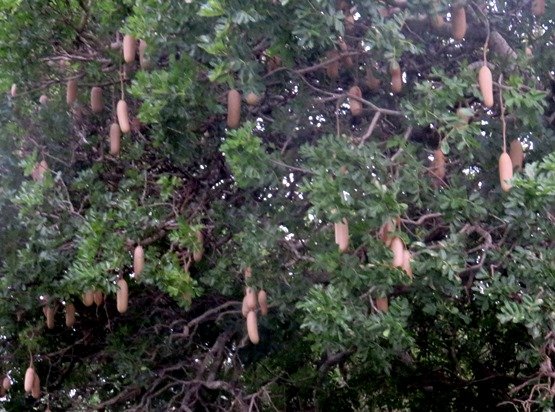Kigelia africana many fruits

Author: Ivan Lätti
Photographer: Ivan Lätti
A successful season allows a big sausage tree to display its annual achievement like this. Up to 1 m long (usually 50 cm) and 10 cm to 18 cm in diameter, one of these pale grey fruits can weigh 10 kg, typically 7 kg. Many seeds are embedded in the fibrous pulp inside.
Seen in December in the Mjejane Game Reserve, some of these fruits may be hanging on the tree until June; but they are not heavy, they are the tree’s pride. When young, the fruit skin, generally grainy, may be covered in scattered lenticels. The fruit is indehiscent, generally said to be poisonous when young.
Rhinos and bushpigs eat them once they fall down… no earth-bound animal app is available yet for speeding up that process, unless the monkeys and baboons that eat the fruit up high might slip them some.
These sausages form part of traditional medicine as so many things in the veld have taken the fancy of sangomas, the well-trained as well as the high curiosity ones. Skin disorders including cancer, sores, ulcers, acne and syphilis count among the conditions for which treatment using material from the sausage tree has persisted. Experimentation is a feature of the inquisitive mind in every culture, not the exclusive domain of learned First World people in white coats.
Hang one of these in your house and whirlwinds should stay away if thinking habits render you susceptible to such beliefs. Or hang it as a decoration and watch the winds just to make sure. Superstition is not an all or nothing phenomenon, neither is a liberal aesthetic sense. Such mind sets, orientations and belief systems starts small, grow incrementally.
What is a mind that undergoes no change? A book, probably (Coates Palgrave, 2002; Schmidt, et al, 2002; Pooley, 1993; iNaturalist).

